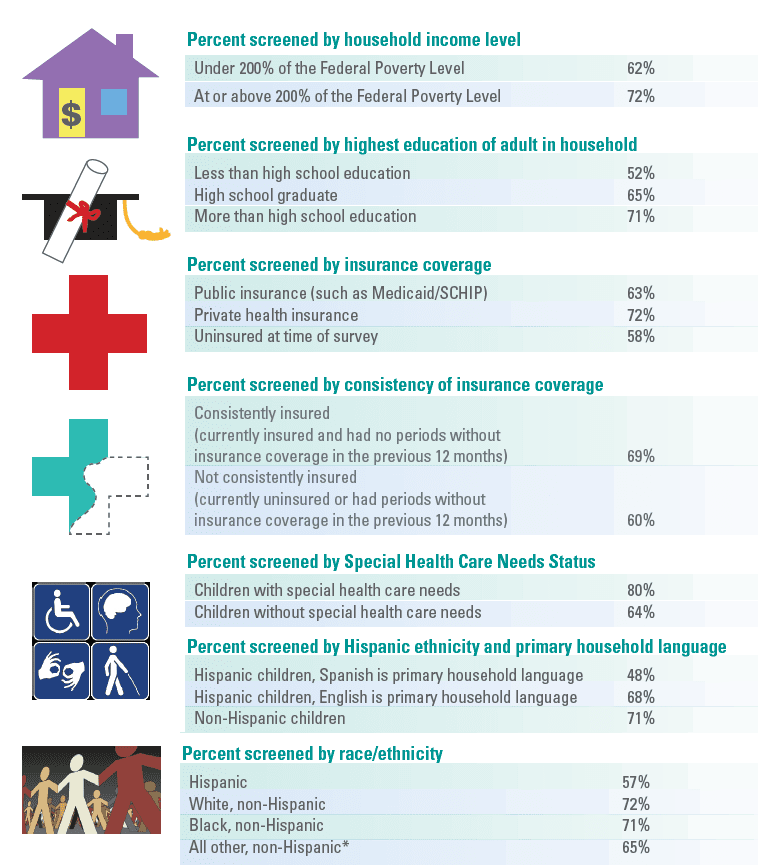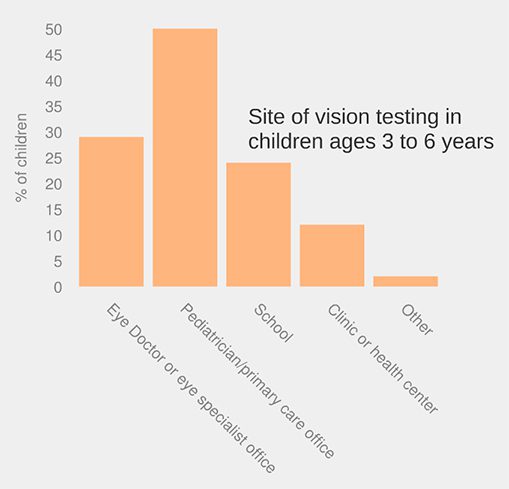Because young children and their parents may not be aware of reduced visual functioning, routine vision screening and/or eye examinations are vitally important to detect problems before the child’s development is compromised. Any possible problem identified by vision screening must be followed up with a comprehensive eye examination. Together, vision screening and eye examinations are complementary and essential elements of a strong public health approach to vision and eye health.
Some form of vision screening for children is mandated in 40 states.
Of those, 40 require vision screening for school-age children. Only 16 states require vision screening for preschool-age children. Few states specify vision screening protocols, and screening methods vary widely from state to state. Additionally, all Head Start and Early Head Start programs—which together serve over one million children younger than 5 years —are required to have a record of a vision screening completed for all enrollees within 45 days of entry. However, there is no national protocol for conducting these screenings.
National Goals and Practice Standards
Early detection and intervention for vision problems are incorporated into national goals and health care standards. The Healthy People 2020 Objective V-1 is to “increase the proportion of preschool children aged 5 years and under who receive vision screening.” The U.S. Preventive Services Task Force recommends vision screening at least once between the ages of 3 and 5 years. National pediatric preventive care guidelines include vision screening by pediatricians yearly at ages 3 through 6 years, and then at regular intervals through late adolescence.
Cost Effectiveness
Due to the time-sensitive nature of amblyopia treatment, vision screening for preschool-age children is considered a cost effective investment. An analysis of the costs and outcomes of three screening scenarios found all three to be cost effective given a “willingness to pay” by policymakers of $4,000 to $10,500 for each case of visual loss prevented (depending on the method of screening). Analyses of cost that take into account the quality-of-life effects of treatment for amblyopia have found that the societal benefits of both vision screening and comprehensive eye exams outweigh the costs.
Screening Rates
Currently, it is difficult to determine with certainty how many children receive vision screening in the United States, because estimates vary depending on the source of data and type of screenings studied.12,13 The main sources of data on screening rates are surveys of parents (or other adult members of households) that typically do not define what constitutes a vision assessment or specify the type of test or provider.
Healthy People 2020 uses the 2008 National Health Interview Survey for baseline data on vision screening. In that survey, 40 percent of children age 5 years and younger had ever had their “vision tested by a doctor or other health professional.” This estimate is consistent with the 2011 National Survey of Children’s Health, which found that 40 percent of children age 5 years and younger had ever had their vision tested, and 83 percent of children ages 6 to 11 years had their vision tested within the past two years.43 Neither survey provides information on the type of test, including whether the children received vision screening or comprehensive eye examinations. However, they do provide national, population-based data that point to significant disparities in vision assessment rates by household income and education levels, insurance coverage, race/ethnicity, and primary household language.
“The absence of a standardized approach to the determination of vision screening rates means that the United States lacks reliable data to track national progress toward vision screening goals or to compare rates of vision screening across states and regions.”
–(Marsh-Tootle WL, Russ SA, Repka MX, 2015)
2011 National Survey of Children’s Health
Receipt of vision screening in children age 17 years and younger

* “All other, non-Hispanic” includes non-Hispanic children reporting more than one race category and non-Hispanic children reporting Asian, Native American, Native Alaskan, or Native Hawaiian (categories that were grouped due to small sample sizes in most states).
The survey asked whether children ever (for ages 0-5) or within the past 2 years (for ages 6-17) had their vision tested with pictures, shapes, or letters.
Source: National Survey of Children’s Health. NSCH 2011/12. Data query from the Child and Adolescent Health\ Measurement Initiative, Data Resource Center for Child and Adolescent Health website. Retrieved February 17, 2015 from www.childhealthdata.org.
Site of vision testing in children ages 3 to 6 years
The medical home is an important site of vision screening. Medicaid’s Early and Periodic Screening, Diagnosis, and Treatment program requires vision services to be provided “at intervals that meet reasonable standards as determined in consultation with medical experts” for all Medicaid enrollees younger than 21 years of age. However, in nine states examined for a 2010 report by the Office of Inspector General of the Department of Health and Human Services, 60 percent of children on Medicaid received no vision screenings. The Centers for Medicare & Medicaid Services does not require states to report vision screenings, and has determined that such a requirement is not feasible at this time due at least in part to the lack of access to data from school-based screenings and the lack of standard billing codes for screening vision in children younger than 3 years of age.

Follow-Up Rates and Systems
As difficult as it is to determine reliable rates of vision screening, it is even more difficult to determine population-based estimates of the percentages receiving diagnostic exams and treatment after failed screenings. No standardized system is in place to track screening and follow up across providers and sites in which screenings occur. A system is sorely needed, both to provide population-level data and to ensure that individual children receive necessary services.
In a study of vision screening within medical home settings, fewer than half of preschool-age children who failed the screening were referred for diagnostic exams. Children who receive referrals do not always obtain the necessary care—as many as two-thirds, in one study.33 Cost, access to providers, and parental awareness of the significance of vision problems pose barriers to receiving eye exams and eyeglasses after failed screens.
Our current knowledge about the outcomes of screening programs and followup care comes primarily from targeted studies of specific programs in limited geographic regions. Without a uniform method to track vision screening results and subsequent access to needed services, even within individual states, we lack vital information for assessing the effectiveness of these efforts and facilitating coordinated, comprehensive care across service systems.
Some states are addressing the lack of population-based data systems by incorporating vision screening and follow-up care into their existing immunization tracking systems (e.g., Michigan, Minnesota, Ohio, Rhode Island). Building on state-level integrated health information systems leverages existing infrastructure(including measures to ensure confidentiality and security) and mechanisms for communication across service sites and providers.
Screening Rates by State
The 2011 National Survey of Children’s Health asked whether children ever (for ages 0-5) or within the past 2 years (for ages 6-17) had their vision tested with pictures, shapes, or letters.
Vision Screening Requirements by State
Information on screening and eye examinations, including ages screened and frequency of screening requirements.
Understanding Vision Screenings and Eye Examinations
To understand screening and intervention in state vision health systems for children, it is important to understand the different roles of vision screenings and eye exams.

